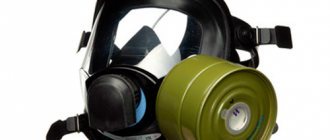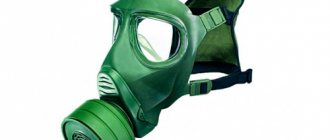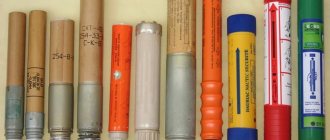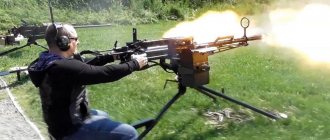Technological progress has become decisive for man in his struggle with the environment. He made us feel safe in front of the raging and aggressive forces of nature. Often the use of various types of chemicals by industry turns into a disaster for the person himself. A leak of poisonous gases can kill an organism defenseless against such a danger. Some salvation here is a gas mask. We will talk about what it is and what the principle of operation of a filter gas mask is in the article.
Filter gas mask device
The device of filtering gas masks includes a front part and a filter-absorbing box.
The front part (gas mask) is made of elastic rubber and, through a tight fit, ensures isolation of the respiratory organs, vision and facial skin from the harmful external environment. The mask includes the body itself, goggles, and inhalation/exhalation valves. Some models can be equipped with a seal, fairings, an intercom, and a liquid intake system.
Some modifications of filter gas masks contain a corrugated hose, which serves as a means of connecting the front part and the filter box. Such models are used mainly in the military sector or industry characterized by particularly hazardous working conditions.
Spectacle units, depending on the model and type of gas mask, can have different design variations: standard location, frontal - for some models of military gas masks, with an increased viewing angle, and instead of shackles there may be panoramic glass.
The valve box of the filter gas mask includes inhalation and exhalation valves. With the help of the valve box, the flows of inhaled and exhaled air are distributed - through the inhalation valve, purified air is directed into the submask space, and with the help of the exhalation valve, exhaled air is released into the atmosphere.
The intercoms included in certain models of gas masks are designed to improve the quality of speech while using the gas mask, and the device for receiving liquid allows you to take water from a special flask without removing the device.
Also, filter gas masks can be equipped with anti-fog films - to protect eyeglass units from fogging, or with insulating cuffs used at sub-zero temperatures to prevent glasses from freezing.
The filter-absorbing box is made of aluminum alloys or tin and contains an anti-aerosol filter and a charge (activated carbon). The anti-aerosol filter is a dense mesh made of fibrous materials, on the walls of which harmful aerosol particles are retained. The absorbent charge is a layer of activated carbon that absorbs dangerous gases and vapors.
All filter gas masks must be equipped with a gas mask bag, which is necessary for storing and carrying them.
Design and principle of operation of insulating
Now let's look at the insulating gas mask: its design, purpose, types, composition, principle of operation, application, where it is used.
The operating principle of such a device is based on the fact that a person breathes purified air inside the device , prepared in advance. Such a device is equipped with a large air tank, reminiscent of a diver's oxygen tank.
He is also equipped with a mask. Its remaining components are presented:
- cartridge for air regeneration;
- breathing bag;
- pipe connection system;
- valve responsible for excess pressure.
The breathing bag together with the cartridge for air regeneration are located in a frame specially designed for them.
The gas mask includes membranes for negotiations, anti-fog films for glasses , and cuffs for reinforcement.
Among insulating gas masks there are subtypes:
- Gas masks containing compressed oxygen and the same air in capsules.
- Gas masks containing oxygen, which is chemically bound. It begins its activation when carbon dioxide interacts with water.
- Hose. For them, the air for inhalation is released from a special purified zone.
An obvious disadvantage of an insulating gas mask is that its use is limited in time : it is used for no more than three hours. Another disadvantage: it is quite difficult to move with it; together with the cylinder and all the additional ammunition, it weighs more than one kilogram.
The impact of electric current on the human body can be extremely negative, including instant clinical death. We will tell you in a special article which means of protection against electricity will help you avoid injury.
Do you know why anti-vibration gloves are needed and what they protect against? Find out the details in this material.
Currently, a huge number of types of gloves are produced, designed for use in various conditions. Find out everything about rubberized gloves in this publication.
The principle of operation of a filter gas mask
A filter-absorbing box, which includes an absorbing layer of active carbon and an anti-aerosol filter, is responsible for cleaning the air entering the submask space.
To purify the air from gases and vapors, a chemical adsorption process is used, the meaning of which is the absorption of harmful impurities by the surface of a solid (in this case, a charge with a layer of activated carbon is used).
Substances with high molecular weight and high boiling point are well suited to the adsorption process. For poorly adsorbed elements, it is common to use processes such as chemisorption (absorption of toxic substances by reacting with chemically active elements) and catalysis (changing the rate of chemical reactions). In the first case, alkaline chemicals are additionally applied to the activated carbon layer; in the second, copper, silver or chromium oxides are added.
The principle of operation of the anti-aerosol filter of the filter-absorbing box of a gas mask is to retain aerosols or large dust particles on the fibers of the mesh of this filter, consisting of dense layers of fibrous materials.
When is replacement required?
Information about the operating time of the boxes will serve as a guide to the operation of the filter for gas masks. Storage periods may vary, depending on the device model. There are several determination methods to determine the need to replace filters. This procedure is required when toxic gas is felt under the mask. The method is dangerous because a high concentration of gases is clearly felt.
Filter replacement is required when the weight of the device changes. This option is suitable for boxes that capture CO. They function at low levels of air humidity, but do not work at high levels. Due to the absorption and binding of moisture, the weight of the device increases.
Replacement may be required after some time of use. The option is suitable for gas masks of brand G. If the device has been used for about 100 hours, then the box must be replaced. Each gas mask may have its own shelf life. It is important to comply with them, as human safety depends on it.
Installation of a new filter can be performed on a schedule. In this case, the boxes must be changed frequently if there are a lot of harmful components in the air. Procedures are also carried out after laboratory tests. Then the shelf life of the filter is determined through experiment. Computer modeling of the period of operation of filters makes it possible to determine negative factors, including temperature and humidity. The replacement time is determined by elements - sensors. Timely installation of the filter allows you to use the device without harm to your health.
Purpose of a filter gas mask
The main purpose of a filter gas mask is to clean the air from toxic impurities before it enters the human body. These types of gas masks are not capable of enriching the air with oxygen, so their use is possible only when the volume of oxygen in the atmosphere is at least 17%. Also, each gas mask filter is designed to protect against specific types of toxic substances, and based on this, they cannot be used if the composition of harmful impurities is not established or is not known in advance.
System of standards for the manufacture and testing of products
Requirements for the production and testing of filter gas masks for civilian use are determined by interstate regulations and state standardization documents .
- A common approach to the safety, production and distribution of the entire range of means used for personal protection in the single space of the Customs Union is regulated by TR CU 019/2011 .
- Technical standards, conditions and terminology are standardized by GOST R 12.4.041-2001; GOST R 12.4.189-99; GOST R 12.4.233-2012; GOST R 22.9.19-2014 .
- A set of mandatory technical conditions, testing and marking methods applied to absorption filters is contained in GOST 12.4.235-2012 and GOST 12.4.246-2013 .
- The methods by which gas masks are tested are regulated by GOST R 22.9.20.
Scope of application of filter gas masks
Filtering gas masks can be used by both ordinary people and industrial workers to protect against harmful gases, vapors, aerosols in the event of emergencies or accidents involving the release of toxic substances into the atmosphere.
Civilian gas masks are designed to protect the population caught in a hotbed of air contamination by dangerous chemical, radioactive, and bacteriological emissions. Used in the event of sudden accidents involving the release of toxic substances, civilian filtering devices do not require prior training for their use, and are more often used when evacuating people from contaminated areas.
Also, filter gas masks are widely used in industrial sectors whose activities involve the storage, production or use in their activities of substances hazardous to human health. All such enterprises are equipped with sets of filtering industrial gas masks in case of unforeseen accidents or emergencies.
General-arms filter gas masks are used during combat operations or military exercises. Such devices often have a more complex design and are equipped with additional elements.
For schoolchildren and preschool children, special models of filter devices that are smaller in size are used.
Modifications
Currently, civilian gas masks are produced: GP-7, GP-9, GP-15, GP-21, UZS VK, MZS VK.
These main types of civilian gas masks are supplemented by design options, especially numerous in the GP-7, and the modified EKRAN UZS VK and MZS VK have a universal mask size with a wide panoramic view.
The category of civil filtering gas masks includes children's versions PDF-2DU and PDF-2SHU , as well as a protective chamber KZD-6 for children under one and a half years old.
Checking filter gas masks
Before direct use, each gas mask needs to be checked - both visually and to check for serviceability.
The first step is an external inspection of all parts of the gas mask. After removing the device from the bag, you need to make sure that all its components are present and intact. The rubber mask should not have punctures, cuts, scratches, the spectacle units should be free of cracks and chips, the valve and filter boxes should also be free of dents, holes and other damage. Metal parts must be free of corrosion or rust. It is also worth checking the presence of all valves in the valve box, the serviceability of the headband straps of the helmet mask, and the tightness of the connection tube to the front part. The gas mask bag must also be checked for integrity and the presence of all straps, fasteners, waist tape, and wooden pads.
After you make sure that all parts of the filter gas mask are present and have no mechanical damage, you need to check the tightness of the front part. To do this, while wearing a mask, you should tightly hold the bottom of the filter box with your palm and try to take a deep breath. If the mask fits tightly to your face, you will not be able to inhale. If air still leaks into the space under the mask, then it is necessary to once again inspect the components of the gas mask for contamination or any malfunctions. Also, you should pay special attention if air passes under the mask in the area of the temples - this indicates that the size of the gas mask is incorrectly selected. In this case, a smaller device should be used.
More effective tests of filter gas masks are carried out in specially equipped chambers, or tents, filled with vapors or aerosols of an irritating substance.
Terms of use
Only filtering devices are issued to the civilian population
, so the instructions describe exactly them. Those who, due to their position or type of activity, are entitled to an isolating model, receive separate instructions when it is issued.
The device, in conditions of possible threat, is worn in a special bag on the stomach. The buttons on the bag should be undone. If necessary, you can study the instructions on how to put on a gas mask correctly:
- Hold your breath.
- Close your eyes.
- Take the gas mask out of the bag with your left hand.
- Remove the plug from the filter box.
- Place your thumbs on the outside of the gas mask, and the rest on the inside.
- Place the bottom of the mask on your chin.
- You exhale.
- Pull the gas mask sharply from the bottom up and straighten it so that there are no folds left.
- Open your eyes and adjust the position of the gas mask so that it does not interfere with your vision.
- Place your bag on its side so it doesn’t interfere with movement.
If you have been given the device for a long time, then keep it clean - do not forget to wipe the lenses of the mask
, especially in safe places where you can remove it. Also monitor the level of exhaustion of the filter box (it will be written on it after what time or under what conditions it should be changed).
And most importantly, try to leave the contaminated area as quickly as possible, especially if your clothing leaves areas of skin exposed.
How to put on a filter gas mask
Putting on a filter gas mask occurs at the command “gases”, after notification of the occurrence of atmospheric contamination, or upon independent detection of such a danger.
Putting on a gas mask is carried out in the following sequence:
1 - close your eyes, hold your breath 2 - if necessary, remove your headgear 3 - remove the gas mask from the bag 4 - put on the gas mask, holding it by the lower part so that only your thumbs remain outside, place the lower part under your chin and pull it with a sharp movement mask on the head 5 – check the tightness of the mask, remove any wrinkles that have formed (if necessary, repeat the procedure of pulling the mask) 6 – exhale, open your eyes, restore breathing
If any part of the gas mask is damaged, either the element or the device itself must be replaced. When replacing a filter gas mask during its operation, it is necessary to prepare a new gas mask for quick donning, hold your breath and close your eyes, remove the damaged device, quickly put on a new one, open your eyes, and restore breathing. If the connecting tube of the gas mask is damaged, then you also need to close your eyes and hold your breath, disconnect the gas mask tube, connect the filter directly to the front part (to the valve box), open the gas, and restore breathing. If damage has formed on the mask, then the breakout points must be pressed tightly with the palm of your hand and not released until you leave the contaminated area. In case of more serious damage to the mask, you need to close your eyes and hold your breath, remove the mask, disconnect the connecting tube from it along with the filter, take the end of the tube in your mouth, pinch your nose with your fingers, breathe through your mouth without opening your eyes. Stay in this state until assistance is provided or leaving the contaminated area.
Classification
There are several different classifications of the device and we will try to consider them all.
Let's consider what filtering and insulating (including hose) gas masks are intended for, what their action is based on, how they differ from each other, their purpose and photo. The main purpose of gas masks for all varieties is the same - protection, but there are certain specifications and conditions for the implementation of this function.
According to the method of protection and type of design, there are two types of gas masks - filtering and insulating:
- Filtering
. A filter box is used, designed to preserve organs from those threats whose entry into the respiratory tract can be stopped using a mechanical filter or a chemical reaction. When using a gas mask of this type, its owner
continues to breathe the surrounding air
, but having gone through purification.Such devices protect at any given moment only from a certain type of threat, since filter boxes are not universal, and also require replacement of these boxes as they are used up. The service life of the filter varies from several days to a couple of tens of minutes and depends on its type, as well as on the level of environmental pollution.
- Insulating
. A device with a compressor box is a much more advanced level of protection, which is also completely universal. An oxygen-insulating gas mask is designed to protect the respiratory system in conditions of oxygen deficiency. The differences between insulating gas masks and filtering ones are that they
owners breathe the atmospheric air that does not surround them
, but with clean air from another source.Such gas masks are divided into two types, based on the type of source - self-contained breathing apparatus
(when the owner has his own compressor box, which contains a cylinder of compressed air) and
hose respirators
(when air is supplied through a hose from an external source, such as a compressed air pipeline).Combined options are also often used, when the main supply goes through a hose, but in case of an emergency there is also a small autonomous cylinder.
Insulating gas masks look like this photo:
Filtering gas masks are also distinguished by type of protection
, which is usually identified by letter and color markings on the filter box. The number after the marking indicates the level of protection as it increases - “1” protects only from low concentrations of gases (up to 0.1%), “2” already allows you to breathe in an atmosphere with 0.5% of toxic substances, and “3” allows you to survive in a place with a concentration greater than 1%.
The marking of a gas mask can be composite if the filter protects against more than one type of toxic substances:
- “P”
, the color of the gas mask box is white. Such filters protect against foreign particles and only protect against coarse dust, but “P3” can already withstand suspended particles, mists, bacteria and viruses. - “A”
, color – brown. Protection from organic gases and vapors with a boiling point above 65 °C. - “AX”
, color – brown. The same thing, but for substances with a boiling point less than 65 °C. - “B”
, color – gray. Protection against inorganic gases, including chlorine, fluorine, hydrogen sulfide, etc. Does not protect against carbon monoxide. - “E”
, color – yellow. Protection against nitric acid vapors and acid gases. - "K"
, color - green. Protection against amines – volatile ammonia derivatives. - “NO”
, color – blue. Protection against nitrogen oxides, in particular highly toxic NO2. - “Hg”
, color – red. Protection against mercury vapor and its volatile organic compounds. - "Reaktor"
, color - orange. Protection from radioactive elements, including iodine and methyl iodine. - "SX"
, color - purple. Protection against chemical warfare agents – sarin, soman, etc. - "CO"
, color - purple. Carbon monoxide protection. Such filters increase their weight as they are used, and the number after the marking indicates the maximum permissible deviation from the norm, after which the filter must be replaced.
There is also a classification according to areas of application, according to which the types of gas masks are distinguished into:
Marking
Filter boxes for a gas mask may have the following markings:
- A (brown): protects against gasoline, kerosene, acetone, benzene, toluene.
- B (yellow): does not allow chlorine, sulfur dioxide, hydrogen chloride, hydrogen sulfide, phosgene to pass through.
- G (yellow-black): protects against mercury and organic substances.
- KD (gray): does not allow ammonia and hydrogen sulfide to pass through.
- E (black): protects against the penetration of arsenic and phosphorus hydrides.
- M (red): does not pass through organic matter, ammonia, acid gases.
- CO (white): protects a person from carbon monoxide.
- BKF: protects against acid gases, organic vapors, aerosols, arsenic hydrides, phosphorus.
Boxes come in large, medium and small volumes, which determines the duration of protection from contaminated air. If they have anti-aerosol filters, then the operating time is reduced. It can be detected by the presence of a white vertical stripe, and on small boxes - by the white color of the bottom. Boxes A, B, KD, G, E without aerosol filters are designated by the number 3. Therefore, their markings can be presented in the form - A3B3Reactor2. In this case, the gas mask filter has class 3 protection type A. The warranty on such parts can be within 3-5 years.










